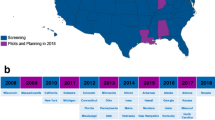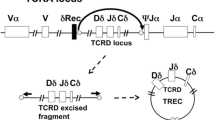Abstract
Severe combined immunodeficiency is a life-threatening primary immune deficiency characterized by low numbers of naïve T cells. Early diagnosis and treatment of this disease decreases mortality. In 2008, Wisconsin began newborn screening of infants for severe combined immunodeficiency and other forms of T-cell lymphopenia by the T-cell receptor excision circle assay. In total, 207,696 infants were screened. Seventy-two infants had an abnormal assay. T-cell numbers were normal in 38 infants, abnormal in 33 infants, and not performed in one infant, giving a positive predictive value for T-cell lymphopenia of any cause of 45.83% and a specificity of 99.98%. Five infants with severe combined immunodeficiency/severe T-cell lymphopenia requiring hematopoietic stem cell transplantation or other therapy were detected. In summary, the T-cell receptor excision circle assay is a sensitive and specific test to identify infants with severe combined immunodeficiency and severe T-cell lymphopenia that leads to life-saving therapies such as hematopoietic stem cell transplantation prior to the acquisition of severe infections.



Similar content being viewed by others
Abbreviations
- SCID:
-
Severe combined immunodeficiency
- HSCT:
-
Hematopoietic stem cell transplantation
- NBS:
-
Newborn screening
- TREC:
-
T-cell receptor excision circles
References
Puck JM. Population-based newborn screening for severe combined immunodeficiency: steps toward implementation. J Allergy Clin Immunol. 2007;120(4):760–8.
Brown L, Xu-Bayford J, Allwood Z, Slatter M, Cant A, Davies EG, et al. Neonatal diagnosis of severe combined immunodeficiency leads to significantly improved survival outcome: the case for newborn screening. Blood. 2011;117(11):3243–6.
Buckley RH. Transplantation of hematopoietic stem cells in human severe combined immunodeficiency: longterm outcomes. Immunol Res. 2011;49(1–3):25–43.
Routes JM, Grossman WJ, Verbsky J, Laessig RH, Hoffman GL, Brokopp CD, et al. Statewide newborn screening for severe T-cell lymphopenia. JAMA. 2009;302(22):2465–70.
Chan K, Puck JM. Development of population-based newborn screening for severe combined immunodeficiency. J Allergy Clin Immunol. 2005;115(2):391–8.
Baker MW, Laessig RH, Katcher ML, Routes JM, Grossman WJ, Verbsky J, et al. Implementing routine testing for severe combined immunodeficiency within Wisconsin's newborn screening program. Public Health Rep. 2010;125 Suppl 2:88–95.
Baker MW, Grossman WJ, Laessig RH, Hoffman GL, Brokopp CD, Kurtycz DF, et al. Development of a routine newborn screening protocol for severe combined immunodeficiency. J Allergy Clin Immunol. 2009;124(3):522–7.
Douek DC, Vescio RA, Betts MR, Brenchley JM, Hill BJ, Zhang L, et al. Assessment of thymic output in adults after haematopoietic stem-cell transplantation and prediction of T-cell reconstitution. Lancet. 2000;355(9218):1875–81.
Accetta D, Syverson G, Bonacci B, Reddy S, Bengtson C, Surfus J, et al. Human phagocyte defect caused by a Rac2 mutation detected by means of neonatal screening for T-cell lymphopenia. J Allergy Clin Immunol. 2011;127(2):535–8.
Sirvent N, Monpoux F, Pedeutour F, Fraye M, Philip P, Ticchioni M, et al. Jacobsen's syndrome, thrombocytopenia and humoral immunodeficiency. Arch Pediatr. 1998;5(12):1338–40.
Eberle P, Berger C, Junge S, Dougoud S, Buchel EV, Riegel M, et al. Persistent low thymic activity and non-cardiac mortality in children with chromosome 22q11.2 microdeletion and partial DiGeorge syndrome. Clin Exp Immunol. 2009;155(2):189–98.
Griffith LM, Cowan MJ, Notarangelo LD, Puck JM, Buckley RH, Candotti F, et al. Improving cellular therapy for primary immune deficiency diseases: recognition, diagnosis, and management. J Allergy Clin Immunol. 2009;124(6):1152–60.
This work was supported by funding from the Children's Hospital of Wisconsin, the Jeffrey Modell Foundation, the Wisconsin State Laboratory of Hygiene and by Cooperative Agreement 5U01EH000365 from the Centers for Disease Control and Prevention. Its contents are solely the responsibility of the authors and do not necessarily represent the views of the Centers for Disease Control and Prevention.
Author information
Authors and Affiliations
Corresponding author
Rights and permissions
About this article
Cite this article
Verbsky, J.W., Baker, M.W., Grossman, W.J. et al. Newborn Screening for Severe Combined Immunodeficiency; The Wisconsin Experience (2008–2011). J Clin Immunol 32, 82–88 (2012). https://doi.org/10.1007/s10875-011-9609-4
Received:
Accepted:
Published:
Issue Date:
DOI: https://doi.org/10.1007/s10875-011-9609-4




